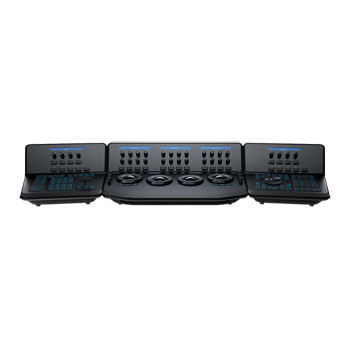DaVinci Resolve Advanced Panel by Blackmagic Design
DaVinci Resolve Advanced Panel - The Ultimate Colour Correction Solution With Professional Control Surface
Scan Code:LN52797
Manufacturer Code:DV/RES/AADPNL
Customer Reviews and Q&A
Blackmagic Design - 'DaVinci Resolve Advanced Panel'
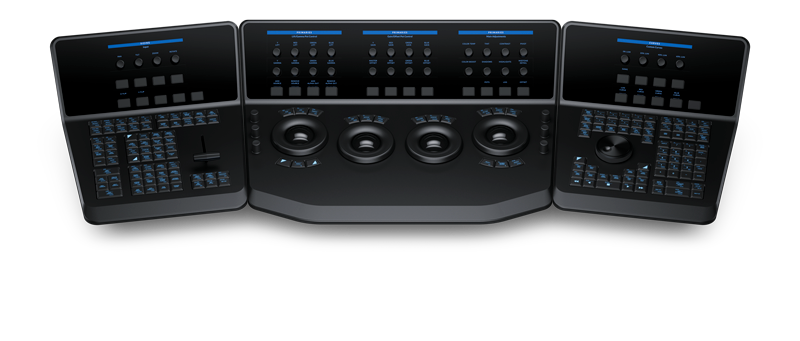
Work Faster and Get More Creative ControlDesigned in collaboration with professional colourists, the DaVinci Resolve Advanced Panel combines three ergonomically connected control surfaces and a pull out keyboard to give you quick, one touch access to virtually every parameter in the program. Each control has a separate high-quality soft key, knob, high resolution weighted trackball or ring so you can accurately fine tune any parameter.
Masterfull Control
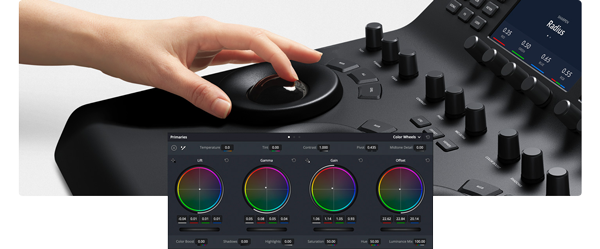
Professional TrackballsThe trackballs let you adjust the colours in an image based on lift, gamma and gain tonal ranges. Unlike a mouse and keyboard, you can manipulate multiple trackballs simultaneously to create unique effects. The smooth gliding rings around the trackballs let you set master levels and establish dynamic contrast. Keys above each trackball reset the colour adjustment, level adjustment or both. Three keys at the top of the DaVinci Resolve Mini and Micro Panels let you switch between primary and log wheel modes, activate offset, temperature and tint controls and turn on your full screen viewer output. The DaVinci Resolve Advanced Panel has a fourth master gain trackball to adjust the entire image.
Detailed Control

Primary Adjustment ControlsPrimary adjustment controls affect the luminance and chrominance of your entire image using a variety of tools that target specific tonal and hue ranges. These tools represent the most common adjustments required to produce dynamic imagery, making them a popular choice for photographers, graphic designers and colourists working on a tight deadline. The DaVinci Resolve Micro Panel and Mini Panel include 12 primary colour correction control knobs that make it easy to quickly adjust image contrast, saturation, hue, temperature, tint, midtone detail, colour boost, shadows, highlights and more. All knobs can be pressed to instantly reset the control so you can easily experiment with new looks.

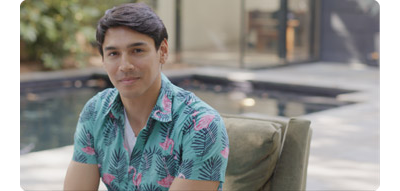
Y Lift, Y Gamma and Y GainThe dedicated lift, gamma and gain knobs, which are sometimes referred to as shadows, midtones and highlights, allow you to adjust the luminance, or
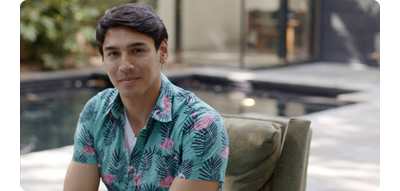
brightness, of each specific area of an image’s tonal range. With these specific controls, you adjust brightness without affecting colour saturation.

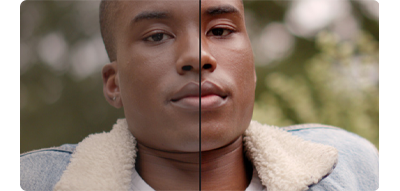
Contrast and PivotContrast is used to change the tonal difference between light and dark parts of an image. Pivot adjusts contrast "balance" which can offset the contrast tonal ranges. Once contrast is set, use pivot to refine the tonal centre of tonality, brightening or darkening the image while retaining contrast.
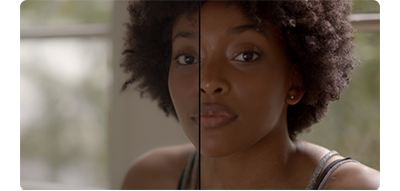
Midtone DetailIncreasing or decreasing midtone detail changes the contrast on edge details in an image. Adjusting midtone detail changes the perception of sharpness and definition. It can be used to accentuate the stubble on an actor’s face, make a scene look sharper, or to gently defocus skin for beauty work.


Colour BoostColour boost intelligently adjusts areas of low saturation in an image while leaving heavily saturated areas alone. This results in a more subtle and natural increase of colour. Sometimes referred to as a vibrance, colour boost is a great way to make colours pop without over saturating the entire image.
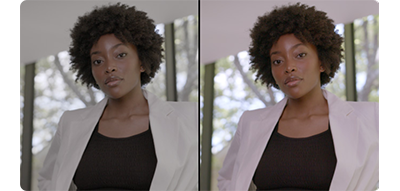
Shadows and HighlightsShadow and highlight knobs let you lighten and darken shadow detail or retrieve blown out highlights in high dynamic range images. They do not affect the midtones, allowing you to achieve a smooth blend and more natural result between the retrieved areas of the image and the unadjusted midtones.

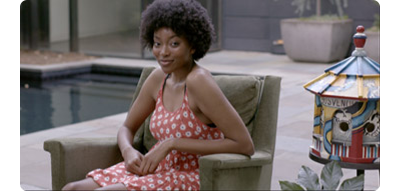
SaturationUse to adjust overall image saturation. At higher values, colours appear more intense, while at lower values colour diminishes. Saturation can be decreased
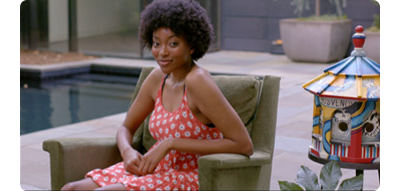
completely until all colour is gone, leaving a grayscale image. Combine with contrast and pivot to produce striking black and white imagery.

HueThe hue knob lets you rotate all hues in an image or selected area around the perimeter of the colour wheel. The default setting is 50, which retains the original unaffected distribution of hues. Use with secondary selections to quickly adjust specific hue ranges, like blue skies or green trees.
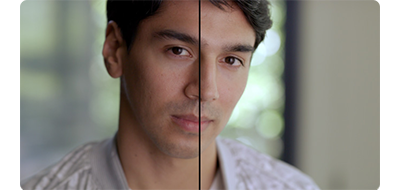
Luminance MixThe luminance mix control changes the balance between your colour adjustments and Y, or luminance only adjustments. When using the Y channel lift, gamma and gain controls, a luminance mix of 100 lets you adjust colour independent of brightness, which is ideal for colour balancing and matching footage.
Dedicated Feature Buttons
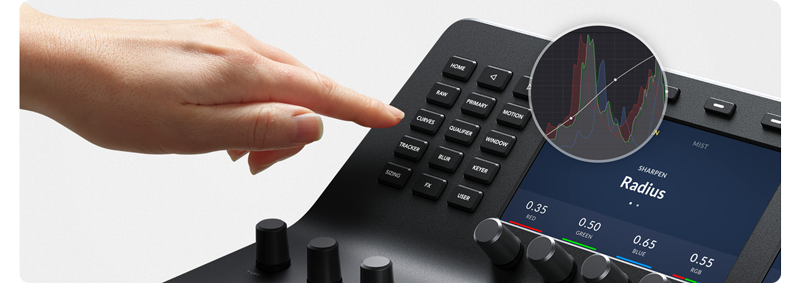
Quickly Change ToolsDozens of creative colour grading, effects, and technical tools are organized in DaVinci Resolve’s colour page in the form of individual palettes. This way, the program is able to feature a variety of intensive toolkits that support a wide range of workflows, while keeping the interface tidy and user intuitive. The DaVinci Resolve Mini Panel and DaVinci Resolve Advanced Panel include dedicated feature buttons that let you quickly access the colour page palettes, so you don’t have to switch back and forth between the mouse and panel. With the push of a button you can easily access tools such as the RAW palette, primary colour correctors, curves, qualifiers, windows, tracker and many more.
Primary Colour Control

Primary Colour CorrectionPrimary bars allow more subtle changes to individual colour channels and luminance than trackballs. DaVinci Resolve Mini Panel and Advanced Panel let you adjust primary bars in their displays. Rotate several knobs at once to quickly achieve a look without having to switch between bars with a mouse.
Create Custom Curves
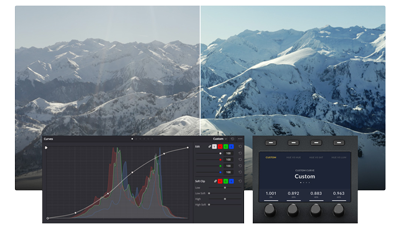
Custom and HSL CurvesCustom curves can be used to make precise adjustments to image luminance and chrominance. Isolate colour channels using the buttons above the displays and rotate the knobs to adjust channel luminance in 20% increments. Use the soft keys over the displays to access the full range of HSL curves.
Power Windows™
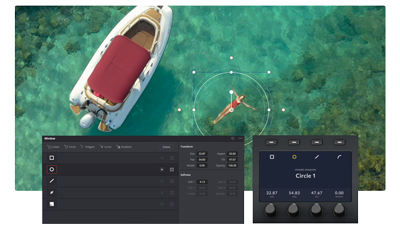
Power Windows™The Advanced and Mini Panels let you create Power Windows, which are shape based objects used for targeting corrections to a part of the image. You can create different window shapes such as squares, circles, polygons, or gradients! Then position, resize and grade the windows with the primary tools.
Qualifier Tool
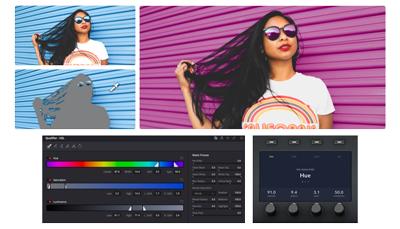
QualifiersThe qualifier tool isolates a portion of the image based on a combination of ranges for hue, saturation or luminance. Press the qualifier button, then choose a qualifier mode and make a key selection. Once a selection is made, use standard primary tools to make adjustments in the selected area.
Tracking Controls
TrackingThe tracking controls can be used to analyze a moving object in a scene so that it can be followed. For example, you could draw a bezier Power Window around a car and then track it through the shot. Once tracked, whatever primary colour correction you add to the Power Window will follow the car.
Built-in Stills Store
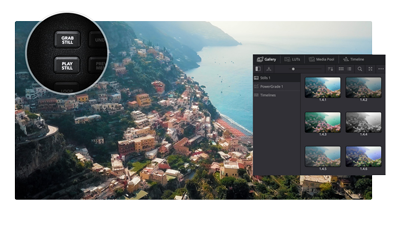
Still StoreThe still store saves colour corrections in the gallery, along with a preview, so you can re apply it to other clips later. DaVinci Resolve colour panels have keys to quickly save, preview and recall stills. The DaVinci Resolve Advanced Panel has a T‑bar fader to wipe between stills for comparisons.
Built-in High Resolution Displays
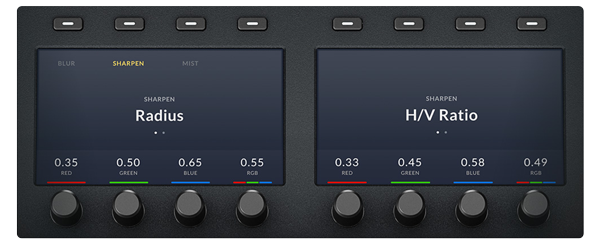
High Resolution DisplaysColour displays on the DaVinci Resolve Mini Panel and DaVinci Resolve Advanced Panel give you precise control over tools in the colour page. On the Mini Panel, when a palette is selected from the list of keys, the screens display its unique interface and settings. Use the arrow keys to navigate between a palette’s modes or pages. The soft keys above the displays let you isolate channels, choose presets, or perform other feature selections specific to the palette type. The soft knobs under the displays can be used to make parameter adjustments. You can generate preset Power Window shapes and track them without touching your mouse! All changes made in the displays are visible on the colour page.
Backlit Keys and Ergonomic Controls
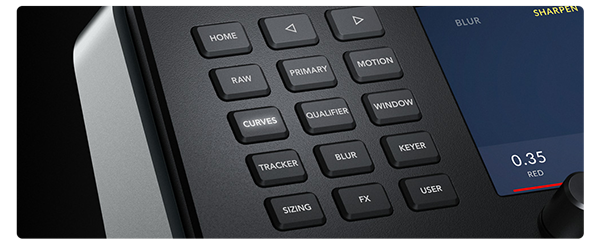
Illuminated Keys and Soft KnobsGrading tends to be performed in low light conditions to ensure a more accurate representation of colours in the grading monitor. The keys and soft knobs on the DaVinci Resolve colour panels illuminate when selected so you can easily see which controls are active in low light. On the DaVinci Resolve Mini Panel and Advanced Panel, the keys are also backlit so it’s easy to find and press each button. The backlight colour of the Advanced Panel keys can even be customized. With 30 customizable soft knobs on the DaVinci Resolve Advanced Panel and 8 on the DaVinci Resolve Mini Panel, you get high resolution, flexible parameter adjustments that you can reset back to the default with a simple push.
Built-in Jog/Shuttle
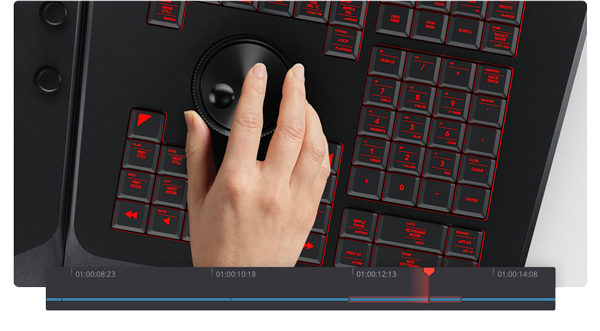
Navigation and Transport ControlsThe area to the right of the trackballs features keys which help you navigate between clips on the timeline, step through clip frames, and jump between nodes in the node editor. These navigation keys can save you a lot of time by keeping your hands on the panel, instead of reaching for the mouse when performing common tasks, such as switching nodes. The play forward, reverse and stop transport keys give you full control of your project timeline or deck. The DaVinci Resolve Advanced Panel adds a jog/shuttle knob for faster and more precise scrubbing. Additional keys on the panels allow for looped playback and temporary grade disabling, making it easy to review clips and check your grade.
Built-in Slide Out Keyboard
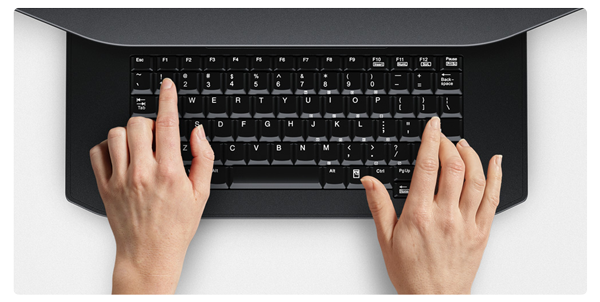
Slide out keyboardThe DaVinci Resolve Advanced Panel gives you quick access to every feature on the color page, minimizing the need for a mouse or keyboard. However, a vital component of the post production workflow is organization and labelling. Use the Advanced Panel’s slide out keyboard to enter clip metadata, name imported files and generators, clearly label nodes in the node editor, or put notes on clip flags and markers. Further optimize the keyboard by assigning custom shortcuts, or by using one of several shortcut preset preferences. When you're finished, the keyboard retracts into the control surface, giving you a clean hardware interface that allows you to return to focusing on the grading tools.
Auto Switching Power Supply
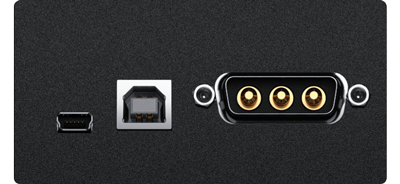
Flexible Power OptionsThe DaVinci Resolve Advanced Panel features an auto switching international power supply, making it compatible with mains power anywhere in the world.
